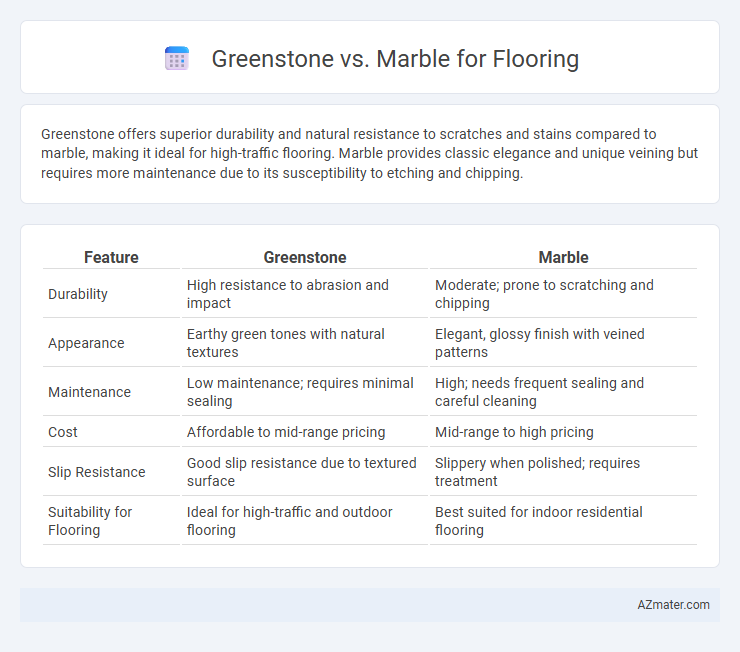Greenstone offers superior durability and natural resistance to scratches and stains compared to marble, making it ideal for high-traffic flooring. Marble provides classic elegance and unique veining but requires more maintenance due to its susceptibility to etching and chipping.
Table of Comparison
| Feature | Greenstone | Marble |
|---|---|---|
| Durability | High resistance to abrasion and impact | Moderate; prone to scratching and chipping |
| Appearance | Earthy green tones with natural textures | Elegant, glossy finish with veined patterns |
| Maintenance | Low maintenance; requires minimal sealing | High; needs frequent sealing and careful cleaning |
| Cost | Affordable to mid-range pricing | Mid-range to high pricing |
| Slip Resistance | Good slip resistance due to textured surface | Slippery when polished; requires treatment |
| Suitability for Flooring | Ideal for high-traffic and outdoor flooring | Best suited for indoor residential flooring |
Introduction: Greenstone vs Marble for Flooring
Greenstone and marble are popular natural stone options for flooring, each offering unique aesthetic and functional qualities. Greenstone is valued for its durability, rich green hues, and resistance to wear, making it ideal for high-traffic areas. Marble is renowned for its elegant veining, timeless beauty, and smooth finish, but it requires more maintenance due to its softer composition and susceptibility to staining.
Material Composition and Origins
Greenstone, primarily composed of metamorphosed basalt and rich in minerals like chlorite and epidote, originates from volcanic regions and offers exceptional durability and resistance to wear. Marble, formed from recrystallized limestone composed mainly of calcite or dolomite, is sourced from sedimentary rock deposits and is prized for its elegant veining and smooth texture. The distinct mineral compositions and geological origins of greenstone and marble influence their performance, appearance, and suitability for flooring applications.
Aesthetic Appeal and Design Versatility
Greenstone offers a unique, earthy aesthetic with deep green hues and natural veining that provide a sophisticated, organic look ideal for modern and rustic interiors. Marble, renowned for its classic elegance, features high-gloss surfaces and diverse color variations ranging from white to black, enhancing design versatility across traditional, contemporary, and luxurious spaces. Both materials allow for creative patterning and finishes, but marble's polished shine often suits formal settings while greenstone's matte texture brings subtle richness to casual or nature-inspired designs.
Durability and Longevity
Greenstone offers exceptional durability with its dense composition, making it highly resistant to scratches and wear, ideal for high-traffic areas. Marble provides elegant aesthetics but is softer and more prone to etching and scratching, requiring more maintenance to preserve its longevity. For flooring, greenstone generally outperforms marble in terms of long-term durability and resistance to damage.
Maintenance Requirements
Greenstone flooring requires minimal maintenance due to its dense structure, offering high resistance to scratches and stains, making it ideal for high-traffic areas. Marble, while luxurious and elegant, demands regular sealing and careful cleaning to prevent etching and discoloration from acidic substances. Choosing greenstone over marble reduces long-term upkeep efforts and costs, especially in environments prone to moisture and heavy use.
Cost Comparison
Greenstone flooring generally incurs higher upfront costs due to its rarity and extraction complexity, ranging from $15 to $30 per square foot. Marble is more widely available, leading to lower average prices between $10 and $25 per square foot, depending on grade and origin. Maintenance expenses for both materials should be considered, as marble requires frequent sealing, potentially increasing long-term costs compared to the more durable greenstone.
Environmental Impact and Sustainability
Greenstone flooring demonstrates superior environmental benefits due to its natural abundance, low extraction energy, and minimal processing emissions, making it a sustainable choice for eco-conscious construction. Marble extraction and refinement consume more energy and generate higher carbon emissions, contributing to environmental degradation and resource depletion. Choosing greenstone flooring supports reduced ecological footprints and aligns with sustainable building certifications like LEED and BREEAM.
Slip Resistance and Safety
Greenstone offers superior slip resistance compared to marble due to its naturally textured surface, making it a safer choice for high-traffic areas and wet environments. Marble's polished finish, while aesthetically appealing, tends to be more slippery when wet, increasing the risk of slips and falls. Selecting greenstone flooring enhances safety by providing better traction and minimizing accidents in both residential and commercial spaces.
Installation Process and Considerations
Greenstone flooring requires professional installation due to its hardness and density, often necessitating specialized cutting tools and heavy-duty adhesives to ensure a secure fit. Marble installation demands careful handling because of its softer composition and susceptibility to chipping; installers typically use thinset mortar and must account for moisture sensitivity by sealing the stone before and after installation. Both materials require precise leveling and grout application to prevent cracking, with marble needing additional maintenance to protect its polished surface from stains and etching.
Which Flooring is Right for You?
Greenstone flooring offers exceptional durability and a unique natural appearance with its deep green hues and subtle veining, ideal for high-traffic areas requiring long-lasting materials. Marble flooring provides a classic, luxurious look with its polished surface and wide range of colors and patterns, perfect for creating elegant spaces but requires more maintenance due to its porous nature. Choosing between greenstone and marble depends on your priorities for durability, maintenance, aesthetic preference, and the specific environment where the flooring will be installed.

Infographic: Greenstone vs Marble for Flooring
 azmater.com
azmater.com